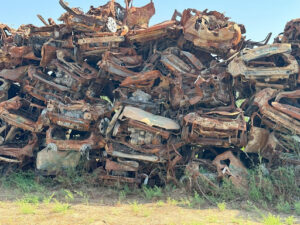Editor’s Notes:
My Visit to the South of Israel
Steven J. Stein
My wife and I had planned a trip to Israel back in November 2023 to visit our daughter living in Jerusalem. However, following the attack on October 7 our flight was cancelled, and we knew we would have to rebook once it was safer to travel there.
Well, this June we made the trip. The mood in Israel was quite different from my previous visits. While Tel Aviv and Jerusalem were very much alive with people everywhere, the vibe was certainly different. There seemed to be more of an edginess in the air. Interestingly, people in Jerusalem that I would spontaneously speak with on the streets seemed to be more optimistic and happier than people I spoke with in Tel Aviv.
I felt compelled to want to travel south to bare witness to the stories and destruction that had occurred on October 7. While not everyone thought that was a good idea, I didn’t even think twice about finding a driver and guides to take me there. I was assisted by both the UJA and JNF and am grateful to them.
Sderot
My first stop was in Sderot, a town of 38,000 residents, 800 meters from the Gaza border that I had visited before. They have been on the receiving end of Qassam rockets from Gaza for many years. Residents in Sderot have 15 seconds from the sound of a warning siren to reach a safety shelter.
Since October 7, they received 220 direct hits from missiles, 2,500 properties damaged, 700 rockets fired at them during the war, and 68 residents murdered on October 7.
I was taken to the new resilience center that was under construction and being funded by JNF. I was shown what will become rooms for individual and group therapies as well as an auditorium/classroom.
Some of the people working on the construction site were reserve soldiers who had recently returned from tours of duty in Gaza. They each wanted to share their stories with me of where they were in the early hours of October 7, how they responded that morning, and their experiences while deployed in Gaza.
The supervising engineer was a commander in the Golani brigades. He commanded 120 soldiers. His unit was involved in the rescue of some of the hostages in Gaza. One of them was Noa Argamani, whose rescue was widely publicized. He shared a number of stories and photos taken in Gaza.
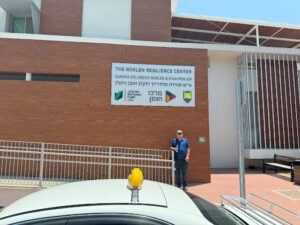
After that I visited the existing operating resilience center pictured above. Their focus is on resilience as opposed to trauma. They provide a variety of evidence-based treatment modalities as well as training for professionals. They currently have a huge waiting list of clients even though not all the residents have returned to Sderot. It’s estimated that about 85% have returned.
The resilience center offers workshops and training courses, international response teams, research and development, a technological resilience incubator, a conference and knowledge center, and a simulator.
Right near the resilience centre (the next block) was the police station which had to be destroyed by the IDF after it was taken over and occupied by Hamas terrorists. It was the site of a fierce battle that took a number of lives and lasted many hours. Eighteen Israeli police were killed there. 20 civilians were killed who were nearby at a bus stop or just walking on the street. As seen below, the police station has been completely cleared away.
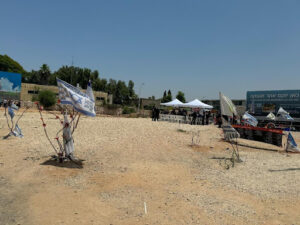
Kibbutz Kissufim
Kibbutz Kissufim is a farming community that had 300 residents and is located right next to the Gaza border. They are one of the largest avocado producers in the country. On October 7, with rockets flying overhead, 70 armed Hamas terrorists attacked the Kibbutz, 35 approaching from each side. They carried out a massacre killing 8 kibbutz members, 6 Thai laborers, and 8 Israeli soldiers. They also took a number of hostages. Many of the housing units were destroyed in the conflict as shown below.
My guide, one of the Kibbutz leaders, and among the few that have since returned to live there, gave me a step-by-step re-enactment of the attack. He pointed out where each firefight occurred, the name and age of each victim, and where he positioned himself, gun in hand, in his own house ready to defend himself. Fortunately for him, the attackers tried each of his doors, which were locked, and then moved on. Unfortunately, his next-door neighbors did not survive.
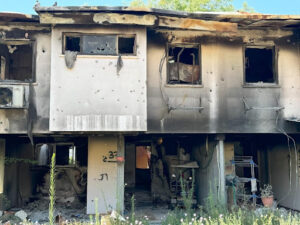
As we walked throughout the Kibbutz, going through each street, I kept hearing a muffled booming sound, like a thunderstorm approaching. I finally asked my guide if we were expecting rain.
“No,” he said, “that’s just bombing. Don’t worry, it’s all going that way,” pointing towards Gaza.
He told me the story of a woman who had one of the nicest houses in the kibbutz. As we stood by her house, he said several months ago she had a few contractors quote for some renovations to her house. She chose a Bedouin contractor who hired a worker from Gaza. They dutifully worked on her house for a couple of months. The worker seemed friendly and would wonder around the kibbutz on his break times.
Several days after the attack, when the main fighting was over, they started to check out the damage and count the bodies still on the ground. He walked me to a spot in a small field, maybe 10 yards from the woman’s house.
“They found the Gaza worker’s body right here,” lying dead next to his weapon.
Nova Music Festival
From there we moved on to the site of the Nova music festival. It had a rather eery feel to it. People were milling about looking at each of the memorial sites. Family members could be seen saying prayers and leaving mementos at the designated site set aside for their loved one.
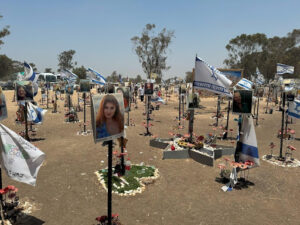
It was quite devastating seeing the faces of so many young people who had so much promise for their futures. A number of them had stories about them next to their photos as shown in the photo below.
As I walked around the site, I heard the sound of an alto saxophone playing a strange combination of notes along with a recording. It was almost as though he was going up and down scales to the rhythm of the recording. He sat in a chair next to one of the memorial posters. I assumed it was a relative. His picture is below.
When he stopped playing, I went to talk with him. As a fellow saxophone player, I thought we could connect talking about music, something he might be comfortable with. When I eventually asked him whether he was connected to someone who was killed at the festival, he told me that he wasn’t. He lived about 20 kilometres away. After October 7th he became quite depressed. He used to work as a tour guide but could no longer work. Coming to the site each day and playing the saxophone was his therapy.
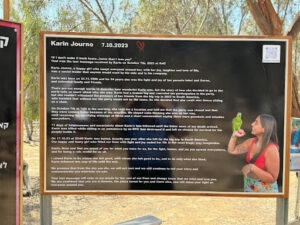

We had time for one last stop before my driver had to return. I spent a lot of time talking to people at each of our stops and I guess he wasn’t quite used to that. He became a bit anxious about the traffic heading back into Jerusalem, but he knew I wouldn’t want to leave without seeing one last sight – the burnt cars.
There were over 300 cars that were destroyed during the various battles that took place on October 7. All the damaged cars, civilian, ambulance, police, military, Hamas trucks, taxis, etc. were placed in this car mausoleum. It’s hard to imaging the weaponry that must have been used to create all this death and destruction.
All in all, it was a very enlightening yet sobering trip. As psychologists we have few tools to explain the mass cruelty that can be unleased by humans upon other humans. No amount of grievance can explain the celebration of violence and destruction that took place here. Perhaps by better understanding hate through psychological research can we begin to comprehend and maybe prevent similar atrocities from reoccurring.
